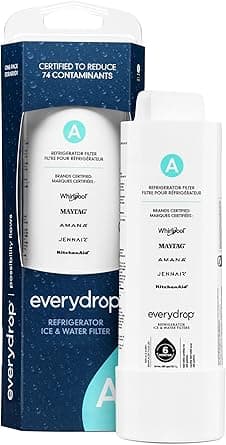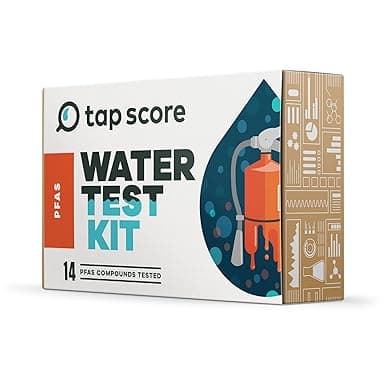Centre Tap Water Quality Report
Centre's water has 10 contaminants above EPA MCLGs. We recommend using a certified water filter.
Utility
CENTRE WATER &
People Served
7,050
MCL Violations
0
Last Updated
Jun 15, 2022
Is Centre Tap Water Safe to Drink?
Centre's water has 10 contaminants above EPA health-based guidelines. We strongly recommend using a certified water filter to reduce exposure to these contaminants. Check our filter recommendations below for NSF-certified options that can remove the specific contaminants found in Centre's water.
The data below shows test results from CENTRE WATER & SEWER BOARD, which serves 7,050 people in the Centre area. Water quality testing is conducted regularly and reported to the EPA. This report was last updated Jun 15, 2022.
Centre Water Quality Test Results
Key Water Quality Metrics
Contaminants Detected
⚠️ Contaminants Above EPA MCLG (10)
Bromodichloromethane
What is Bromodichloromethane?
Member of trihalomethanes (THMs) that form in water treated with chlorine
Health Effects
Health protective benchmarks for BDCM are based on carcinogenicity and liver toxicity observed in animal studies. The EPA has classified BDCM as a probable human carcinogen. Results from animal studies also suggest that kidney, immune system, spleen, and developmental toxicity are associated with exposure to BDCM. BDCM has been shown to produce DNA changes (genotoxicity) in laboratory studies.
Affected Organs
Common Sources
Perfluorooctanesulfonic acid
What is Perfluorooctanesulfonic acid?
Part of a class of synthetic compounds known as per- and polyfluoroalkyl substances (PFAS) widely used to make products more resistant to stains, water, and grease. It is found in fabrics, fire-fighting foams, cleaning products, hydraulic fluids, metal plating, and paper. Although PFOS production has been phased out in the US, exposure is still a major concern due to its high degree of persistence in the environment and in the body as well as the use of legacy products and imported goods. Many adverse health effects have been linked to PFOS exposure, including developmental, liver, and immunological problems and increased cancer risk. EPA has found that there is suggestive evidence that PFOS is a human carcinogen.
Health Effects
As with many PFAS compounds, research into the health effects of PFOS is rapidly evolving. Epidemiological studies have shown associations between elevated PFOS levels and increased total and low-density lipoprotein cholesterol ('bad cholesterol') as well as immune toxicity (decreased antibody response). Animal studies indicate that PFOS exposure is related to adverse developmental effects, liver toxicity, immune toxicity, and an increased risk of liver and pancreatic cancer.
Affected Organs
Common Sources
Perfluorooctanoic acid
What is Perfluorooctanoic acid?
Perfluorooctanoic acid (PFOA) is a synthetic chemical that belongs to a group of chemicals known as per- and polyfluoroalkyl substances (PFAS). It is used in various industrial applications and consumer products for its water- and grease-resistant properties.
Health Effects
Exposure to PFOA has been linked to several health issues, including developmental effects in fetuses, increased cholesterol levels, liver damage, thyroid disease, and certain types of cancer.
Affected Organs
Common Sources
Perfluorodecanoic acid
What is Perfluorodecanoic acid?
Part of a class of synthetic compounds known as per- and polyfluoroalkyl substances (PFAS) widely used to make products more resistant to stains, water, and grease. PFDA has been used in coatings on food packaging, furniture, upholstery, and carpeting, and as a lubricant, plasticizer, and corrosion inhibitor. Like many other PFAS, PFDA is resistant to breakdown in the environment and the body. High levels of ingested PFDA may result in adverse liver, developmental, and immune effects, but research on the health effects of PFDA is still ongoing.
Health Effects
As with many PFAS compounds, research into the health effects of PFDA is rapidly evolving. Epidemiological studies have found associations with PFDA exposure and decreased antibody response to vaccines as well as increases in total and low-density lipoprotein cholesterol ('bad cholesterol'). Animal studies have also demonstrated associations between PFDA levels and liver toxicity, as well as developmental effects (low birth weight and offspring mortality).
Affected Organs
Common Sources
Total THMs
What is Total THMs?
Group of contaminants that form in drinking water systems when a disinfectant, typically chlorine, reacts with organic matter
Health Effects
Drinking water standards for total THMs are based on evidence of carcinogenicity in human and animal studies, as well as liver and kidney toxicity observed in animal studies. Individual THMs have been further associated with developmental, immune, spleen, and genotoxicity.
Affected Organs
Common Sources
Dibromochloromethane
What is Dibromochloromethane?
Member of trihalomethanes (THMs) that form in water treated with chlorine
Health Effects
Health protective benchmarks for DBCM have been developed based on liver toxicity and carcinogenicity observed in animal studies. EPA has classified DBCM as a possible human carcinogen based on animal evidence, while IARC (International Agency for Research on Cancer) says it is unclassifiable as a human carcinogen. Kidney toxicity has also been associated with DBCM based on evidence from animal studies. DBCM has been shown to produce DNA changes (genotoxicity) in laboratory studies.
Affected Organs
Common Sources
Chloroform
What is Chloroform?
Member of trihalomethanes (THMs) that form in water treated with chlorine and is generally the most abundant THM formed in drinking water
Health Effects
Health protective benchmarks for chloroform have been developed based on kidney and liver carcinogenicity observed in animal studies, and liver toxicity observed in occupational studies. The EPA classifies chloroform as a probable human carcinogen based on animal evidence, and there is additional epidemiological evidence that may increase the risk of colon and bladder cancer in humans. Results from animal studies also suggest that exposure to chloroform can cause liver, developmental and immune toxicity. Acute exposure to low levels of chloroform will cause nervous system toxicity.
Affected Organs
Common Sources
Chlorite
What is Chlorite?
Chlorite is a chemical compound that is a derivative of chloric acid. It is often found in drinking water as a byproduct of chlorine disinfection processes. Chlorite can also occur naturally in some water sources.
Health Effects
Exposure to chlorite can lead to various health issues, including irritation of the skin, eyes, and respiratory tract. Ingesting high levels of chlorite can cause gastrointestinal distress and may affect red blood cell function, leading to methemoglobinemia, a condition where the blood cannot carry oxygen effectively.
Affected Organs
Common Sources
Perfluorononanoic acid
What is Perfluorononanoic acid?
Part of a class of synthetic compounds known as per- and polyfluoroalkyl substances (PFAS) widely used to make products more resistant to stains, water, and grease. PFNA serves as a processing aid for fluoropolymers, most notably the temperature resistant plastic used in tanks, valves, batteries, and fishing lines. It has also been used in producing fire-fighting foams. PFNA production is currently being phased out in the US, but exposure is still a major concern due to its high degree of persistence in the environment and in the body, as well as its presence in legacy products and imported goods. Adverse health effects related to elevated PFNA levels include developmental, liver, and immunological toxicity as well as increased cholesterol.
Health Effects
As with many PFAS compounds, research into the health effects of PFNA is rapidly evolving. Epidemiological studies have shown associations between PFNA and increases in total and low-density lipoprotein cholesterol ('bad cholesterol'). Animal studies indicate that PFNA exposure is related to developmental, liver, and immune system toxicity.
Affected Organs
Common Sources
Perfluorohexanesulfonic acid
What is Perfluorohexanesulfonic acid?
Part of a class of synthetic compounds known as per- and polyfluoroalkyl substances (PFAS) widely used to make products more resistant to stains, water, and grease. PFHxS has been used in protective coatings for carpets, paints, and textiles and as a surfactant in industrial processes. It may also be found in food contact papers, fire-fighting foams, and cleaning products. PFHxS production has been phased out in the US, but ongoing concerns exist due to its high persistence in the environment and the body, legacy uses, and presence in imported goods. Exposure to elevated PFHxS levels may result in adverse effects to the thyroid and liver.
Health Effects
As with many PFAS compounds, research into the health effects of PFHxS is rapidly evolving. Epidemiological studies have identified that PFHxS exposure may be associated with immunosuppression (i.e. reduced antibody response, impacting vaccine efficiency). Animal studies suggest PFHxS may cause increased liver weight, as well as adverse effects to thyroid hormone levels, and motor development.
Affected Organs
Common Sources
Understanding the Data
This data comes from your local water utility testing. The bar charts compare detected levels against EPA's Maximum Contaminant Level Goal (MCLG). Contaminants above the MCLG are shown by default and may require filtration. All other tested contaminants are within safe levels and can be viewed by expanding the section above.
Recommended Water Filters for Centre
Based on Centre's water quality data, these NSF-certified filters are recommended to remove contaminants above EPA MCLGs.

Whirlpool Corporation
W11256135
NSF Certified:
Capacity
1001 gal
Filter Life
3 mo
Flow Rate
0.7 gpm
Removes 19 contaminants:
1,2 Dichlorobenzene, 1,4 Dichlorobenzene, 2,4-D, Asbestos, Atrazine +14 more

Whirlpool Corporation
W11569861
NSF Certified:
Capacity
1001 gal
Filter Life
3 mo
Flow Rate
0.52 gpm
Removes 22 contaminants:
1,2 Dichlorobenzene, 1,2,4 Trichlorobenzene, 1,4 Dichlorobenzene, 2,4-D, Asbestos +17 more

iSpring Water Systems LLC
RCC7
NSF Certified:
Daily Production
21.04 gpd
Removes 1 contaminants:
Total Dissolved Solids

iSpring Water Systems LLC
RCC7-BLK
NSF Certified:
Daily Production
25.41 gpd
Removes 9 contaminants:
Asbestos, Barium, Cadmium, Chromium (Total), Copper +4 more
Verify Your Water Quality with Independent Testing
With 10 contaminants above EPA health guidelines, independent laboratory testing provides a second opinion and can track changes over time.

SimpleLab
Advanced Home Water Test
$369
Most comprehensive home water test including all standard tests plus additional parameters for ultimate peace of mind.

SimpleLab
Standard Home Water Test
$232
Comprehensive water analysis testing over 200 contaminants including bacteria, heavy metals, and chemical compounds.

Tap Score
PFAS Forever Chemicals Test
$239
Specialized test for PFOA, PFOS, and 24 other forever chemicals. Essential for areas near military bases, airports, or industrial sites.
Frequently Asked Questions About Centre Tap Water
Centre's water has 10 contaminants above EPA MCLGs. We strongly recommend using a certified water filter to reduce exposure to these contaminants. Check our filter recommendations below for NSF-certified options that can remove the specific contaminants found in Centre's water.